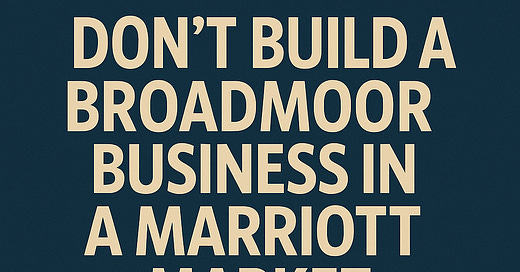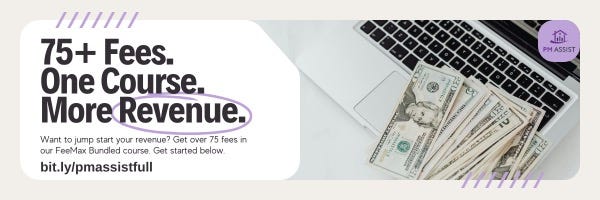Don’t Build a Broadmoor Business in a Marriott Market
Chasing luxury in property management might stroke your ego, but it won’t scale your revenue—here’s why tiered pricing beats boutique glamour.
All of us who attended the NARPM Broker/Owner conference a couple of weeks ago loved the venue, didn’t we? I mean, granted, I’m one of the people who thinks Broker/Owner never should have left Vegas and it’s crazy that we’re in a different location every year (that should be reserved for the National Convention, instead), but if we have to bounce around to these difficult and expensive travel destinations every year, it’s hard to find a better location than the Broadmoor, a truly legendary customer service experience.
But I worry that some people might have learned the wrong lesson from experiencing all of that amazing customer service. I heard more than a few people comment something like “wow, this is the best customer service experience I’ve ever had, we really need to make our PM business this high class!” Wrong lesson, folks. Let’s dive into it.
Wal Mart is Enormous, Neiman Marcus is Tiny
No one will ever say that shopping at Wal Mart is glamorous. Hell, I won’t even shop there because of their notorious union-busting activities. But one thing can’t be denied: Wal Mart is an enormous, extremely successful business. On the other hand, shopping at a place like Neiman Marcus can be an experience. The level of customer care that you’ll receive is unparalleled, the fellow customers are typically well mannered and not dragging screaming kids through the aisles, and the quality of the product is going to be 10X what you’ll get at Wal Mart.
But here’s the thing: Neiman Marcus is a tiny niche player, and Wal Mart is a behemoth. Let’s compare these two retail players (Neiman Marcus was acquired by Saks Global, so we’ll use that umbrella corporation which also includes Saks 5th Avenue, Saks Off 5th, and several smaller stores):
Revenue
Wal Mart - $681 billion
Saks Global - $7 billion
Net Profit
Wal Mart - $19.4 billion
Saks Global - unknown, as it’s privately held, but has been in financial troubles
Number of Stores
Wal Mart - 4,616
Saks Global - 180 (approximate)
Now, let’s be honest, while owning a piece of Neiman Marcus may be an ego play, if you really had a choice as to which of these businesses you would have invested in back in say the year 2000, none of you would select Nieman Marcus. Had you invested $10,000 in Wal Mart stock back then, you would now have $212,963.61 (and that’s assuming that you did NOT reinvest the dividends). If you had invested $10,000 in Neiman Marcus’s stock in 2000 (it was publicly traded at the time), you would have ended up with only $29,600, because the company was bought out and taken private in 2005. The company has struggled ever since with a series of leveraged buyouts, a bankruptcy filing, and constant uncertainty.
The moral of this story is that luxury may look nice, and may be nice to experience as a customer, but it’s not usually the best investment. It’s rare that luxury niche players are the leaders in their space (Delta Air Lines might be the exception here, but even they offer basic economy fares). Whether we look at department stores, restaurants, hotels, or cars, the mass market players are always the behemoths. There simply aren’t that many people out there who can afford luxury, and the larger margins on luxury products and services can never make up the difference in market share. After all, the 1% is called “the 1%” for a reason. Unit economics may be fantastic with enormous margins, but that doesn’t matter much if you can only sell 10 of something with a 50% margin instead of 10,000 of something at a 5% margin. That’s more of an ego play than a real business strategy. This is why these luxury brands so frequently get scooped up by mass market brands and operated as a separate luxury subsidiary. They just aren’t worth much as stand-alone brands, but they give the mass market brand the ability to maintain their customer as they move up the class scale.
Niche is Hard in Property Management
It’s really hard to run a niche luxury brand in the property management business, simply because the volume isn’t there in the vast majority of markets. In huge markets like Atlanta, Dallas, Central Florida, etc., you may be able to run a pretty successful boutique PM business in the luxury niche for discerning property owners and residents, but most markets simply don’t have enough people to grow even a boutique business on this niche segment. And I would wager that most people reading this aren’t looking to just have a boutique 100 door business, they want to get up to at least a modest scale of a few hundred units. You can absolutely forget running a luxury PM brand of over 1,000 doors even in the largest markets. There just aren’t enough owners willing to pay premium prices for premium luxury service.
No, the better strategy in this business is to think more like General Motors (and other major auto brands). GM figured out decades ago that you can run a massive bread-and-butter brand like Chevrolet to appeal to the vast majority of consumers, but still not lose them as they make more money and advance up to more luxurious cars by operating separate luxury brands under their same corporate umbrella. So today, GM operates Chevy (64% of sales), GMC (23%), Buick (7%), and Cadillac (6%). You want an affordable family sedan when you’re a young family not making much money? GM has you covered with Chevy. You’re making a little more money and you need a reasonable but slightly upscale family SUV? GMC is there for you. You’re getting older and you’re making a lot of money and you want a luxurious SUV? Splurge on a Cadillac. All under the same corporate umbrella, and with tons of synergies (you may not realize this, but that $100k Cadillac still has a bunch of Chevy parts in it, and sometimes even the platform/frame is identical).
So how do we match this model in property management? Simple: tiered pricing. A tiered pricing model of Good/Better/Best or Silver/Gold/Platinum can basically be your version of Chevy/GMC/Cadillac.
Silver - the budget option; your Chevy
Gold - upgraded options but still appealing to a large segment of the market; your GMC
Platinum - your luxury brand, reserved for the clients who are looking for only the best; possibly an all-inclusive pricing model; your Cadillac
Any of these tiers could be its own business, and Silver and Gold can probably both be scalable businesses on their own in large markets, but Platinum is too niche to be anything more than a boutique player, and in tertiary markets you’ll likely need to offer all three to reach modest scale.
Just like GM uses synergies between its brands, you are able to do the same thing between your tiers. You’re offering different levels of service to different clients, but your same team can offer all of them, they’re just offering different things to different people based on which tier they’ve selected. With automation and process platforms like LeadSimple and Aptly now out there, this can even be reliably systematized to ensure that mistakes aren’t made in the level of service offered. This used to be a lot more difficult when you had to check someone’s PMA each time something came up, but now conditional logic in software can handle all of that for you automatically.
Ego Doesn’t Pay Mortgages
Ultimately, luxury brands are mostly about ego and prestige, and neither of those things pays the bills. BMW didn’t buy Rolls Royce Motor Cars because it was going to be a huge boon to their financials. In reality, Rolls Royce represents about 1% of their sales volume by units, and probably just a few percent more of their total net profit (that number isn’t publicly available). So why did BMW even bother to buy it? Simple: optics. They can claim to own one of the most elite brands of cars ever made under their umbrella. But if BMW was going through financial troubles, auctioning off Rolls to the highest bidder would almost certainly be one of the first things they did to shore up their balance sheet, because it contributes very little to their revenue or profitability. You need to keep this in mind and not get distracted by the glitz and glamour of luxury. Business is about numbers, not ego. At least, it is if you’re smart about it.
We all enjoy a pampering at a beautiful resort location with unparalleled customer service. But few of us are experiencing it very often except for the ultra-wealthy. The Broadmoor is a rare treat, but the Marriott is the typical choice for most of us. It makes a lot more sense to build your business around the Marriott model than it does the Broadmoor model.
Newsletter Stats
Here are our statistics for the last 30 days:
38,752 impressions
46.89% open rate
Issue with the highest readership:
6,193 impressions
Seeking Advertisers
We still have plenty of open spots for advertisers for the year, so if you’re an industry vendor and looking to get the word out to our large audience, please visit our advertiser sign-up page here. All advertisers are welcome. Unlike the PMAssist Partner program, advertising is open to all vendors, not just vendors we use at our own property management company. Advertising tends to be selling out about a month in advance, so please plan ahead if you want specific dates for your ads.




